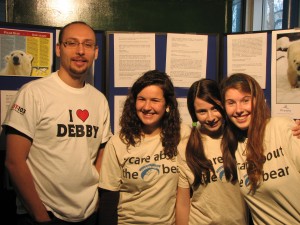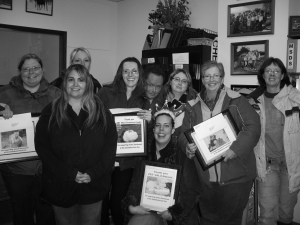Premiere Greg Selinger was on hand at the Assiniboine Park Zoo today to announce a huge commitment to polar bear conservation at the Assiniboine Park Zoo. Here are a few news articles for more information:
Dec. 03, 2009 at 2:30 pm CDT in News
Posted by Sarah Klein
A big funding announcement was made Thursday for major upgrades to the Assiniboine Park Zoo’s polar bear exhibit.
A $31-million investment will help create the world headquarters of Polar Bears International and a state-of-the-art rescue shelter right here in Winnipeg.
The International Polar Bear Conservation Centre will conduct and co-ordinate polar bear rescue research, conservation and public-education initiatives, Premier Greg Selinger and Hartley Richardson, board chair of the Assiniboine Park Conservancy, said in a statement.
A new arctic exhibit will feature a polar bear enclosure with underwater and above-ground viewing opportunities to enable visitors to come face to face with up to six bears. Current plans call for the exhibit to also feature caribou, arctic fox, snowy owls and musk oxen, said Selinger.
Winnipeg hasn’t had a polar bear since Debby passed away last November.
Construction is slated to begin in 2011.
Polar bear exhibit, shelter eyed for Winnipeg zoo
Last Updated: Thursday, December 3, 2009 | 12:30 PM CT
Debby is seen in her enclosure in Winnipeg’s Assiniboine Park Zoo in December 2006, during celebrations of her 40th birthday. (CBC)
A new polar bear rescue shelter and polar bear exhibit will be the centrepieces of a conservation centre to be constructed at Winnipeg’s Assiniboine Park Zoo.
Manitoba Premier Greg Selinger announced the plan, as well as a contribution of $31 million, on Thursday.
Construction on the centre, which will include a state-of-the-art polar bear enclosure, will start in 2011, said Hartley Richardson, board chair of the Assiniboine Park Conservancy.
The enclosure will have underwater and above-ground viewing opportunities to enable visitors to come face to face with up to six bears, he said.
It will be part of a new arctic exhibit that will also feature caribou, arctic fox, snowy owls and musk oxen, said Selinger.
The zoo has been without a polar bear since its long-time resident, Debby, died in 2008 at age 42. The zoo has not been able to get another polar bear because its enclosure no longer met provincial standards.
Polar bear research
The first of its kind in North America, the polar bear centre will conduct and co-ordinate polar bear rescue research, conservation and public education initiatives, said Selinger.
It will also co-ordinate a relocation network that will facilitate the process for permanently placing orphaned or injured animals in qualifying zoos.
“As the home of Churchill, the world’s polar bear capital, there is no better place than Manitoba to host this centre of research and education on the impact climate change is having on our polar bears,” Selinger said.
‘As the home of Churchill, the world’s polar bear capital, there is no better place than Manitoba to host this centre of research and education on the impact climate change is having on our polar bears.’—Premier Greg Selinger
Added Richardson: “Manitoba has been a world leader in the management of polar bears, which have become an international symbol for climate change’s effects on the world. We are very pleased to see this exciting initiative is moving forward.”
Polar Bears International, a non-profit organization dedicated to the worldwide conservation of polar bears and their Arctic habitat, applauded the province on the plans and leadership involving the animals.
“The Polar Bear Alert program and the Manitoba standards for polar bears in zoos are just two examples of this leadership,” said Robert Buchanan, CEO of Polar Bears International.
“By providing funding for the international polar bear conservation centre, Manitoba will remain on the cutting edge in terms of polar bear research and stewardship.”
Assiniboine Park Conservancy is a non-profit corporation mandated to establish a vision for the park, create a plan to ensure it realizes its visions and govern the implementation of strategies toward the revitalization and transformation of the park.
Polar bears’ early arrival eyed
Province to announce funding; construction could start in 2011
By: Bartley Kives and Bruce Owen
3/12/2009 1:00 AM
The Assiniboine Park Zoo has been without a polar bear since Debby died last year at age 42.
The Assiniboine Park Conservancy may begin building a state-of-the-art polar-bear enclosure in 2011, years earlier than previously expected.
This morning, the Manitoba government plans to announce a contribution toward the International Polar Bear Conservation Centre, a $5-million enclosure and education facility slated for Assiniboine Park Zoo.
The largest zoo in Manitoba, the self-proclaimed polar bear capital of the world, has been without a member of the iconic Arctic species since 2008, when 42-year-old zoo resident Debby died. The zoo is unable to acquire another adult polar bear because its existing bear enclosure, built in the 1950s, no longer meets Manitoba Conservation standards for the species.
Young polar bears, however, could be housed at the zoo temporarily as part of a plan to make Winnipeg the centre of international polar-bear education as well as rescue efforts for orphan polar bears found anywhere in the Arctic.
The non-profit Assiniboine Park Conservancy plans to build a polar-bear centre that will include a new enclosure with an underwater viewing area, an interactive link to polar-bear denning grounds near Churchill as well as a polar-ecology and climate-change research facility.
Young polar bears could arrive even before construction begins.
“If a polar bear becomes available, we’ll do our best to ensure it finds a home,” zoo co-ordinator Gordon Glover said in June, when the plan was first announced.
“We will have a facility that will allow them to survive in way that’s decent and respectful for them,” Premier Greg Selinger said Wednesday.
Zoo visitors likely won’t be able to see the orphan cubs, which will be fed and cared for behind closed doors in order to acclimatize them for life in other zoos.
Orphan polar bears are never returned to the wild, where they would die of exposure, starvation or cannibalistic predation.
“We’re not doing this to show people polar-bear cubs, as cute as they are. We’re doing this to keep cubs alive,” Bob Williams, the Canadian chairman for Polar Bears International, also said in June.
Selinger would not say Wednesday how much the province will contribute to the new polar-bear centre. No federal funding is involved, but the conservancy is seeking private donors.
The polar-bear facility is the most dramatic aspect of a $90-million Assiniboine Park Zoo revitalization plan.
bartley.kives@freepress.mb.ca bruce.owen@freepress.mb.ca
Republished from the Winnipeg Free Press print edition December 3, 2009


